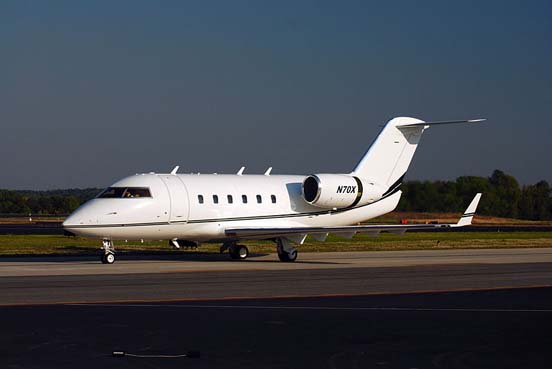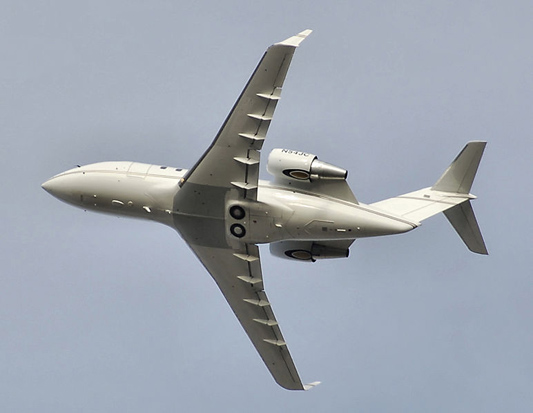 |
|
Bombardier Challenger 600 |
By
Wikipedia,
the free encyclopedia,
http://en.wikipedia.org/wiki/Bombardier_Challenger_600
The Bombardier Challenger 600 series is a family of business jets designed by Bill Lear and produced first by Canadair until that company was bought by Bombardier Aerospace in 1986.
Development
 | |
The Challenger 600 experimental |
The aircraft was an independent design by Bill Lear in 1976, who had resigned as Chairman of Lear Jet seven years previously. Originally dubbed the LearStar 600, Lear sold exclusive rights to produce and develop the design to Canadair, who renamed it the CL-600 Challenger.
While similar in general configuration to Lear's previous designs, notable changes were made that distinguished the new aircraft from the Learjets, including the use of a widened fuselage that allowed a 'walk-about cabin', a feature not shared by any other business aircraft of the time. The Challenger was also one of the first bizjets designed with a supercritical wing.
On 8 November 1978, the first prototype of the aircraft took off for the first time in Montreal, Canada. An 3 April 1980 test flight in the Mojave Desert resulted in disaster, the aircraft crashing due to a deep stall, killing one of the test pilots (the other parachuted to safety). The second and third prototypes flew in 1979.
Despite the crash, both Transport Canada and the Federal Aviation Administration in the United States certified the aircraft in 1980, albeit with both handing over some restrictions to pilots including a limited maximum take-off weight. A large program to reduce the aircraft's weight was then implemented to improve the aircraft's range.
Variants
 | |
Bombardier Challenger 601 shortly after take off. The main undercarriage wheels are left exposed during flight |
CL-600
- CL-600 - original production version, powered by Avco Lycoming ALF 502L turbofans of 7,500 lbf (33.6 kN) thrust each. Built until 1983 (83 built)
- CL-600S - 76 CL-600s retrofitted with the winglets introduced on the CL-601-1A. 12 aircraft purchased by Canadian Forces Air Command for use in a variety of roles as the CC-144, CE-144, and CX-144.
CL-601
- CL-601-1A - refined version including winglets to reduce drag and more powerful General Electric CF-34 engines. (66 built, including 4 CL-144s)
- CL-601-1A/ER - 601-1A retrofitted with an additional fuel tank in the tail
- CL-601-3A - engine with a higher flat rating and a glass cockpit. This was the first version marketed by Bombardier.
- CL-601-3A/ER - 601-3A with an additional, optional fuel tank in the tail
- CL-601-3R - the tail tank was made standard, and airline style 'unsided' engines (no left or right) were used, matching what was used on the CRJ.
CL-604
- CL-604 - major upgrade of the 601 design, incorporating more powerful engines, larger fuel supply, including saddle tanks in the rear of the aircraft, completely new undercarriage for a higher takeoff and landing weight, structural improvements to wings and tail, and a new Collins ProLine 4 avionics system. The C-143A is a single Challenger 604 aircraft, which was acquired by the United States Coast Guard in December 2005 as its new Medium Range Command and Control Aircraft (MRC2A).
CL-605
- CL-605 - Introduced in early 2006 as an avionics and structural upgrade of the 604 design. Structural improvements include larger cabin windows. Cockpit instrumentation updated with the Collins Proline 21 avionics and "electronic flight bag" capability. It can be visually identified by a new, rounded tailcone.
CL-610
- CL-610 Challenger E was to have been a stretched version with seating for 24 passengers. Development was halted by Canadair in 1981 without any having been built. A few years later, a new project would develop the Canadair Regional Jet based on a stretched Challenger design.
Operators
Military operators
 Argentina Argentina
 Australia Australia
 Canada Canada
 China China
 Croatia Croatia
 Czech Republic Czech Republic
 Denmark Denmark
 Germany Germany
 United States United States
Specifications (CL-601-3A)
General characteristics
- Crew: Two (pilot & co-pilot)
- Capacity: Up to 19 passengers, depending on configuration
- Length: 20.85 m (68 ft 5 in)
- Wingspan: 19.61 m (64 ft 4 in)
- Height: 6.30 m (20 ft 8 in)
- Wing area: 48.3 m² (520 ft²)
- Empty weight: 9,292 kg (20,485 lb)
- Max takeoff weight: 19,550 kg (43,100 lb)
- Powerplant: 2× General Electric CF34-3A turbofans, 40.7 kN (9,140 lbf) each
Performance
See also
Related development
Comparable aircraft
External links
Text from Wikipedia is available under the Creative Commons Attribution/Share-Alike License; additional terms may apply.
Published in July 2009.
Click here to read more articles related to aviation and space!
|
 |



